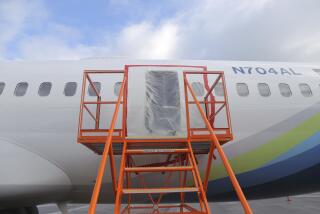Foam Theory Is Bolstered by Shuttle Data
CAPE CANAVERAL, Fla. — Columbia’s salvaged data recorder registered unusual temperature spikes in the left wing just seconds after the shuttle experienced the peak heat of reentry, indicating the craft was mortally wounded before it began its descent, an official close to the investigation said Sunday.
And that makes flyaway foam from the shuttle’s fuel tank an even stronger suspect for breaching the leading edge of the wing, said the official, speaking on condition of anonymity.
A chunk of foam broke off the external tank during Columbia’s liftoff on Jan. 16 and sideswiped some of the heat-resistant carbon panels on the leading edge, and possibly some of the metal and tiles underneath.
Laura Brown, a spokeswoman for the Columbia Accident Investigation Board, said the recorder tape holds a significant amount of good data from at least 420 sensors on Columbia’s wings, fuselage and tail, mainly temperature and pressure measurements.
The temperature surges in the leading edge were captured on tape 16 seconds after Columbia began experiencing peak heating in its plunge through the atmosphere on Feb. 1, Brown said. These unusual temperature readings -- apparently caused by the searing gases that penetrated the left wing, almost certainly along the leading edge -- occurred more than a minute earlier than previously reported, she added.
Data transmitted from Columbia to Mission Control during the flight’s final minutes indicated a temperature surge in the left main landing gear just before the shuttle crossed the California coast.
Brown noted that the analysis of the recovered tape will continue throughout this week, and that investigators hope to learn a little more each day about what happened to Columbia just before it broke apart over Texas. All seven astronauts were killed.
More to Read
Sign up for Essential California
The most important California stories and recommendations in your inbox every morning.
You may occasionally receive promotional content from the Los Angeles Times.










